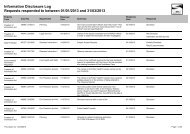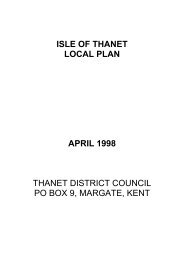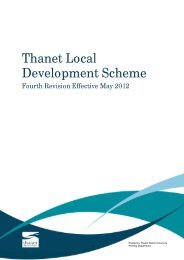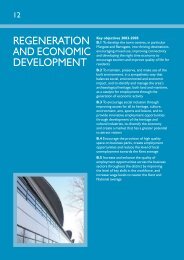Thanet Cycling Plan - Spokes
Thanet Cycling Plan - Spokes
Thanet Cycling Plan - Spokes
- No tags were found...
You also want an ePaper? Increase the reach of your titles
YUMPU automatically turns print PDFs into web optimized ePapers that Google loves.
<strong>Thanet</strong><strong>Cycling</strong>PLANDecember 2003
c ontents1.Introduction Page 31.1 Why Promote <strong>Cycling</strong>1.2 Policy Background1.3 The Place of <strong>Cycling</strong> in <strong>Thanet</strong>’s Transport Strategy1.4 Progress to Date2.Strategy Page 4Eight Main Areas of Action2.1 Cycle Friendly Design Pages 4 & 52.2 Cycle Network Pages 5 & 62.3 Cycle Parking Page 72.4 Integration with Public Transport Page 82.5 Promotion Pages 8 & 92.6 Education and Training Page 92.7 Dialogue and Consultation Page 102.8 Monitoring Page 103.What You Can Do Now… Page 11Contacts: Local and National Page 12Short Term Routes 2002-2005 Page 13Medium Term Routes 2006-2008 Page 14Long Term Routes 2009-2011 Page 152
1 Introduction1.1 Why Promote <strong>Cycling</strong><strong>Cycling</strong> has many advantages as a means of transport. Bicycles occupy little space,save energy and cause no air or noise pollution. They are cheap to use and toprovide for. <strong>Cycling</strong> is good exercise and is beneficial to individual health.1.2 Policy BackgroundTransport policy in the UK saw significant changes during the 1990s. A number of"milestone documents", for example The UK Strategy for Sustainable Development1994 and PPG13: Transport recognised the importance of cycling, but The National<strong>Cycling</strong> Strategy 1996 firmly established cycling as "a central factor in offering anenvironmentally sustainable and health promoting local transport option".This policy shift towards a more integrated transport system and the recognition thatthere must be viable alternatives to private car travel, has been continued by thepublication of the Government White Paper A New Deal for Transport: Better forEveryone in 1998 and the Transport Act in 2000.1.3 The place of cycling –in <strong>Thanet</strong>’s transport strategyThree quarters of journeys to work in <strong>Thanet</strong> are of less than three miles. <strong>Cycling</strong> isusually quicker over this distance than either car or public transport. An increasedrole for the bicycle can make a significant contribution to reducing car use in <strong>Thanet</strong>,as an efficient and economic form of transport.In 1998 just 3% of journeys to work in <strong>Thanet</strong> were made by bike. As part of the<strong>Cycling</strong> <strong>Plan</strong> we aim to increase these percentages substantially.Targets1 – To increase the percentage of journeys to work by cycle to 12% by 2012 (to beconsistent with The National <strong>Cycling</strong> Strategy).1.4 Progress to dateThis is <strong>Thanet</strong>’s second cycling plan (or strategy). The first, published in 1995,included an action plan to 2001. The majority of the targets in that plan have beenachieved, and indeed some have even been exceeded.The most notable achievements since 1995 have been:•The opening of the Viking Coastal Trail in June 2001, linking <strong>Thanet</strong>’s towns andvillages together with a 45km (28-mile) circular route and joining them to theNational Cycle Network.•The completion of the Broadstairs ‘Safer Routes to School’ initiative.•The creation of 66km of new cycle routes in <strong>Thanet</strong>, two "toucan" crossings tohelp cyclists, and an extensive programme of cycle parking provision in shoppingcentres which is still ongoing.3
2 StrategyWe propose eight main areas ofaction:• Cycle friendly route design.• Expansion of the cycle network.• Improvements to cycle storage, parking and other workplace facilities for cyclists.• Integration with public transport.• Encouragement and promotion.• Education and training.• Dialogue and consultation.• Monitoring.Cycle friendly route design and expansion of the cycle route network arecomplementary.Cycle friendly design involves designing to improve both safety and convenience forcyclists. This will lead to a much safer and more attractive road network for cycling.However a specific cycle network is vital to ensure continuity of safe facilities linkingto important destinations.2.1 Cycle friendly designAll cycle journeys use ordinary roads for at least part of their length. Therefore, toencourage cycling, as much as possible of the road network must be cycle friendly.To achieve this we will give high priority to assisting cyclists in all trafficmanagement and traffic calming schemes, in the design of new developments, andin any new road construction. The following policies and actions will be pursued:Policies1 – All traffic management and calming schemes will aim to make the road networkmore cycle friendly. There will be a presumption in favour of incorporating facilitiesto benefit cyclists in all schemes. So:a) Schemes involving signalled junctions will generally incorporate facilities such ascycle lanes and advanced stop lines, while pelican crossing schemes will beassessed as potential "toucans".b) Segregated facilities or cycle lanes will be provided as part of all new roadschemes, ensuring safe passage through junctions.c) Traffic calming will use cycle friendly measures.d) Cyclists will generally be exempted from all new road closures, one-wayrestrictions and banned turns, except where there is a technical or safety case fornot doing so.e) Cycle parking will be provided in appropriate locations.4
Policies2 – A Cycle Audit will operate in parallel with the Road Safety Audit to ensureadherence to appropriate and high quality design standards.3 – "Kent Design" will require cycle friendly new development, both in overalllayout and detailed design.Targets2 – To provide cycle facilities at 50% of signalled junctions by 2005 and all by2008, wherever practicable.2.2 Cycle networkExpansion from existing routes will aim towards a comprehensive safe networkcatering for all journey purposes. Urban networks will aim to link to all significantdestinations, such as employment and shopping centres, schools and colleges. Thealready well-developed longer distance network and National Cycle Network will link<strong>Thanet</strong>’s towns to each other, to other towns in East Kent and to the countryside.Existing and proposed cycle routes in <strong>Thanet</strong> are shown on pages 13, 14 and 15.While off-road paths have an important role in the networks, many routes use bothmajor and minor roads. On main roads forming part of the cycle network, prioritywill be given to achieving continuous facilities. With appropriate design, trafficcalmed streets and minor roads offer good conditions for cycling.Policies4 – Cycle network proposals will be further developed in consultation with the<strong>Thanet</strong> <strong>Cycling</strong> Forum and other interest groups.5 – Safeguarding will be sought for proposed routes in the Isle of <strong>Thanet</strong> Local<strong>Plan</strong>.In urban areas we intend to start by concentrating resources where cycling isalready relatively popular. Higher existing cycle use should help to achievesupport for cycle facilities and to generate increases in cycling. Early prioritieswill be:a) Completing the Viking Coastal Trail along Margate seafront.b) Improved crossing facility on the Viking Coastal Trail at the A256 SandwichRoad/Foads Lane junction in Cliffsend.c) Completing the programme of Viking Coastal Trail links to railway stations, i.e.Birchington and Broadstairs. Improved facilities would provide increasingopportunities for combined cycle and public transport journeys, and providefor increased cycle tourism.d) A254 Margate to Westwood. Improving access to QEQM Hospital,Westwood Industrial Estate and Westwood itself.e) Palm Bay to Westwood. Linking residential areas of Cliftonville toWestwood, Christ Church University College, <strong>Thanet</strong> Reach Business Parkand four secondary schools.f) Birchington/Westgate to Garlinge/Hartsdown Park. Avoiding the main A28,serving two secondary schools and expanding leisure opportunities at Quex Parkand Hartsdown Park.g) Margate to Broadstairs via Dane Valley. Linking the Millmead/Dane Valleyresidential area to the two towns and to the Oakwood Industrial Estate.The cycle network shown on pages 13, 14 and 15, is likely to cost upwardsof £2m, and an increase in the resources available for cycling will be needed.5
Medium Term Routes2006-2008Crown copyright reserved Licence No. LA076708 Kent County Council14
Long Term Routes2009-2011Crown copyright reserved Licence No. LA076708 Kent County Council15
If you have any comments on this document please email them to:cyclingplan@thanet.gov.ukor contact:Stuart SmithCommunity & Public Transport Officer<strong>Thanet</strong> District Council, Council Offices, Cecil Street, Margate, Kent CT9 1XZTel: 01843 577607 Fax: 01843 853383Phil PittockSenior Transport <strong>Plan</strong>nerKent County Council, 2 Beer Cart Lane, Canterbury, Kent CT1 2NNTel: 01227 825362 Fax: 01227 464765Design & Production SEA 01227 768808
















